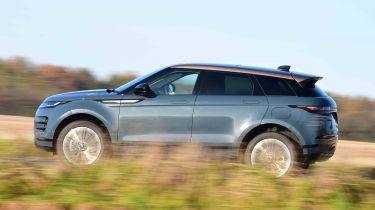Range Rover Evoque - Engines, performance and drive
The Range Rover Evoque is comfortable and refined, but not the most thrilling car to drive in its class

Unlike its sportier JLR stablemate, the Jaguar E-Pace, the Range Rover Evoque hasn’t been designed to offer outright thrills to its driver. On a twisty country road, there’s a bit of body lean in tight bends, some slack in the steering at the straight-ahead position, and less front end grip than that of the Jaguar.
The trade-off between body control and ride quality seems well-judged, though, particularly in regular petrol and diesel versions. The extra weight of the battery pack in the plug-in hybrid version can be noticed when driven a little more aggressively, but never to the extent that it feels like it’ll get out of shape.
Once you get the Evoque onto the motorway, it comes into its own. Here, the refinement and comfort levels on offer have taken a big step on from those of the old car; Land Rover’s engineers have made sure that the Evoque is a cosseting cruiser rather than a sports car in an SUV body. In this respect, the Evoque compares favourably with the Volvo XC40, a small SUV with a similar outlook on life. Even on the largest 21-inch wheels, ride quality is excellent.
It’s not terribly likely that any Evoque will venture off-road, but being a Land Rover product, the car does boast impressive skills when the going gets rough. Wading depth has increased from 500mm on the old car to 600mm, while Land Rover’s Terrain Response 2 system can automatically adjust the Evoque’s behaviour to suit the conditions at hand. The supplied Comfort, Sand, Grass-Gravel-Snow and Mud and Ruts settings can each be selected manually too.
0-62mph acceleration and top speed
The entry-level D165 2.0-litre turbocharged diesel produces 161bhp and manages a 0-62mph time of 10.1 seconds. Next is a 201bhp D200 version of that engine that cuts the 0-62mph time to 8.5 seconds.
The entry point into petrol Evoque ownership is the P200, which brings a 2.0-litre turbocharged petrol engine with 197bhp and a 0-62mph time of 8.6 seconds. The P250 ups power to 246bhp, dropping the 0-62mph sprint to 7.6 seconds.
The P300 is no longer on sale, so for those seeking genuine hot-hatch levels of performance, they’ll need the P300e plug-in hybrid. It features a 197bhp 1.5-litre three-cylinder petrol unit driving the front wheels, while at the rear axle, there’s an electric motor with an output of 107bhp, for a combined 305bhp. The PHEV is no slouch, reaching 62mph from a standstill in 6.4 seconds and moving on to a maximum speed of 132mph. It can also run on electric power up to speeds of 84mph.








